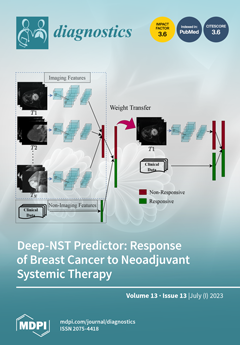68Ga-DOTATOC PET could be a noninvasive, highly sensitive, and specific technique for the challenging diagnosis of optic nerve sheath meningioma (ONSM). Our objective was to report the use and results of
68Ga-DOTATOC PET in suspected ONSM. Twelve subjects who underwent
68
[...] Read more.
68Ga-DOTATOC PET could be a noninvasive, highly sensitive, and specific technique for the challenging diagnosis of optic nerve sheath meningioma (ONSM). Our objective was to report the use and results of
68Ga-DOTATOC PET in suspected ONSM. Twelve subjects who underwent
68Ga-DOTATOC PET for suspected ONSM in our department were retrospectively included. Standardised clinical and radiological data were collected. The PET examination results were classified as positive or negative, and lesion standardised uptake values (SUV
max) were recorded.
68Ga-DOTATOC PET confirmed positive uptake in six cases (SUV
max > 5), leading to ONSM diagnoses followed by radiation therapy in patients with vision loss. Six
68Ga-DOTATOC PET scans were considered negative (SUV
max < 5); these comprised one case of neurosarcoidosis, one cavernous malformation, and four uncertain diagnoses, leading to further investigation.
68Ga-DOTATOC PET was helpful in tumour volume delineation before radiation therapy, leading to a decrease in dose exposure. Noninvasive
68Ga-DOTATOC PET should be performed before treating nonhistologically proven meningiomas with radiotherapy or stereotactic radiosurgery, particularly in cases of uncertain diagnosis with MRI, which characterises most ONSM cases. PET SUV
max thresholds to distinguish meningioma from nonspecific uptake in other lesions need to be adapted to ONSM.
68Ga-DOTATOC PET improves the intraorbital lesion diagnostic approach and therefore impacts therapeutic management.
Full article






